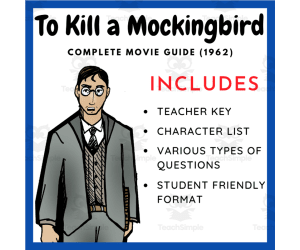2,807 products added recently
Character Chart
A Character Chart allows students to delve into the complexities of characters within a narrative. By visually organizing information about a character's actions, thoughts, and interactions, students can better understand their roles and significance within the story. This tool aids in developing comprehension and interpretative skills, enriching the literature learning experience.
To Kill a Mockingbird (1962): Complete Movie Guide & Character Reference Chart
ELA, Reading, Reading Comprehension, Grade 7, 8, 9, 10, 11, Charts, Teacher Tools
The story is told through the eyes of Finch's daughter, Scout (Mary Badham), who is about six years old when the events of the film take place. Scout, along with her brother Jem (Philip Alford) and their friend Dill (John Megna), become fascinated with the trial of Tom Robinson (Brock Peters), a black man who is accused of raping a young white woman. As the trial unfolds, it becomes clear that Robinson is innocent and that the case is simply a product of racial prejudice and fear. Despite the evidence in Robinson's favor, the all-white jury finds him guilty, and he is sentenced to death. The trial, and the events leading up to it, cause a great deal of turmoil in the small town of Maycomb, Alabama. Finch, who believes deeply in justice and equality, becomes the target of threats and abuse from some members of the community. However, he remains steadfast in his belief that everyone, regardless of race or social standing, deserves a fair trial and equal treatment under the law. In the end, Robinson is killed while attempting to escape from prison, and Finch's own children are attacked by the real perpetrator of the crime. The film ends with Scout realizing the importance of her father's principles and the power of empathy and understanding in a society that is often divided by fear and hatred. This product will help keep your students focused throughout the entire movie. The questions range from simple comprehension questions to short answers. All the questions are in chronological order and a teacher key is provided. I have also included a complete character reference guide to help your students make sense of the various characters. This product will save you time and will help your students! Ready and easy to use! The movie is available on Netflix and on Amazon. Product and thumbnail clipart credit: Illumismart
Author EduPal Learning
Tags To Kill A Mockingbird, Movie Guide, Video Guide


